How mould removal newcastle can enhance your indoor air quality
How mould removal newcastle can enhance your indoor air quality
Blog Article
Discovering the Numerous Strategies and Solutions for Effective Damp Proofing
Dampness in buildings positions considerable difficulties to both structural integrity and indoor air quality. Different strategies and solutions have emerged to fight this prevalent issue. From conventional damp-proof membrane layers to ingenious chemical therapies, each method offers special advantages. Recognizing these choices is essential for efficient wetness control. Nevertheless, selecting the best service depends on particular structure problems and requirements, prompting further expedition into the most effective damp proofing techniques offered.
Understanding the Reasons For Dampness
Dampness can occur from numerous resources, comprehending these reasons is essential for reliable remediation. Commonly, wetness stems from 3 key resources: increasing moist, penetrating damp, and condensation. Rising damp takes place when groundwater takes a trip upwards via porous products, such as brick or stone, often due to an absence of a reliable obstacle (mould removal newcastle). Permeating damp is typically triggered by outside aspects, including roof covering leaks, defective gutters, or harmed walls, permitting water to penetrate a building. Condensation, on the other hand, arises from excess dampness in the air, often aggravated by bad air flow and temperature level differences, causing water beads forming on surfaces. Determining these underlying concerns is essential, as each kind of dampness requires a tailored technique for removal. Correct analysis aids in establishing one of the most effective services, inevitably protecting the structural honesty of a structure and improving indoor air high quality
Traditional Damp-Proof Membrane Layers

Chemical Damp-Proofing Solutions
Chemical damp-proofing remedies offer an innovative approach to preventing wetness invasion in buildings. These techniques usually include the application of liquid chemicals that penetrate stonework and form an obstacle against climbing wet. Commonly utilized chemicals include silanes, siloxanes, and other water-repellent representatives that respond with surface area materials to create a hydrophobic layer.The application procedure generally needs boring holes right into the wall surfaces, infusing the chemical service, and enabling it to cure. This approach is specifically useful for older structures where traditional damp-proof membrane layers might be impractical. Chemical damp-proofing can be much less turbulent and much more affordable than considerable restoration projects.While effective, these remedies depend on appropriate application and ecological problems for peak performance. damp specialist newcastle. Regular upkeep and tracking are important to guarantee the long life of the damp-proofing treatment. Generally, chemical damp-proofing represents a functional choice for safeguarding buildings versus moisture-related damage
Dental Caries Wall Construction Strategies
Dental caries wall construction techniques use various benefits, particularly in wetness control and power effectiveness. By including an air gap between 2 layers of stonework, these wall surfaces efficiently alleviate water ingress while improving insulation. This combination not just protects frameworks from wetness however additionally adds to decreased power consumption.
Benefits of Tooth Cavity Walls
When taking into consideration reliable damp proofing methods, the advantages of tooth cavity wall surfaces stand out prominently. Tooth cavity walls are composed of two separate layers, creating an air gap that efficiently decreases moisture penetration. This style decreases the danger of wetness, as the external wall surface acts as an obstacle versus rainfall and water ingress. Additionally, tooth cavity wall surfaces boost thermal insulation, which adds to power efficiency by reducing heat loss. They also provide sound insulation, helping to develop a quieter interior setting. The air gap allows for air flow, which helps in wetness control and decreases the likelihood of mold and mildew growth. These advantages not just boost the general convenience of a building but additionally add to its durability and structural honesty.
Dampness Control Techniques
Efficient dampness control methods are important in cavity wall surface building to ensure lasting security versus dampness. One key method includes the incorporation of weep holes, which promote water drainage from the tooth cavity, avoiding build-up. Furthermore, using breathable membranes can aid manage wetness degrees while enabling caught vapor to escape. Appropriate positioning of insulation is likewise vital, as it needs to not obstruct drainage courses. Additionally, ensuring that the external fallen leaves of the cavity wall are created with water-resistant products improves total longevity. Regular maintenance checks are necessary to determine any kind of blockages or damage early, securing the framework's honesty. Ultimately, a combination of these methods develops a durable protection versus moisture intrusion in tooth cavity wall surfaces.
Insulation and Power Efficiency
Insulation plays an important duty in enhancing energy performance within cavity wall building. By integrating protecting products, these walls produce a thermal obstacle that lessens warm loss and reduces energy intake. Reliable insulation not only helps keep a secure interior temperature but also alleviates the risk of dampness, as it protects against condensation within the wall dental caries. Different methods, such as using rigid foam boards or mineral woollen, can be employed to accomplish ideal insulation efficiency. In addition, appropriate setup is necessary to guarantee that voids and gaps are minimized, which can or else compromise energy efficiency. Inevitably, a well-insulated dental caries wall surface contributes greatly to general sustainability and reduces heating & cooling expenses for property owners.
Exterior Damp Proofing Techniques
External moist proofing techniques are crucial for safeguarding frameworks from wetness seepage. 2 effective techniques consist of the application of water-proof membranes and the installation of French drains. These options help alleviate water build-up and maintain the honesty of buildings.
Waterproof Membrane Layer Application
While numerous approaches exist for protecting against moisture ingress, the application of water-proof membrane layers remains an extremely effective exterior damp proofing method. These membrane layers are commonly made from materials such as polyethylene, rubber, or customized asphalt, offering a durable obstacle against water infiltration. The setup procedure involves applying the membrane layer to the external surfaces of foundations or wall surfaces, making sure full coverage to stop leakages. Appropriate attachment and securing at joints are critical to making best use of performance. Water-proof membranes can be applied in numerous forms, including liquid finishings and sheet membrane layers, permitting adaptability based upon the specific requirements of the structure. This technique not only secures structures from wetness yet additionally enhances their longevity and structural stability.
French Drainpipe Installation
One efficient approach for taking care of groundwater and preventing moisture accumulation around a building's foundation is the installation of a French drain. This water drainage system contains a trench full of gravel and a perforated pipe that redirects surface water away from the foundation. Proper setup requires careful planning, guaranteeing that the drainpipe inclines away from the structure to help with optimal water flow. Additionally, the location of the drainpipe is essential; it needs to be positioned in areas vulnerable to merging or excess dampness. Routine maintenance, consisting of clearing up particles from the gravel and ensuring the pipe continues to be unhampered, is important for lasting performance. Eventually, a well-installed French drainpipe can greatly reduce the threat of water-related concerns in basements and structures.
Inside Waterproofing Approaches
Inside waterproofing methods are essential for protecting a building's interior from moisture seepage and potential water damage. These approaches normally include the application of specialized materials and methods created to create a moisture barrier within the framework. One typical approach is the use of water-proof layers or sealers on wall surfaces and floorings, which protect against wetness from passing through surfaces.Additionally, mounting interior drain systems, such as sump pumps, can efficiently handle water buildup in cellars and crawl spaces. One more approach involves making use of vapor barriers, which are installed to prevent dampness motion from the ground right into living spaces.Moreover, attending to any kind of cracks or spaces in wall surfaces or structures with appropriate sealants guarantees a detailed defense against water invasion. By applying these interior waterproofing methods, building owners can significantly minimize the threat of mold growth, architectural damages, and various other moisture-related issues. Appropriate implementation of these strategies is essential for long-lasting security and structure integrity.
Regular Maintenance and Evaluation Practices
Routine maintenance and assessment methods are crucial for ensuring the long-lasting efficiency of damp proofing solutions in any kind of structure. Routine checks enable residential property proprietors to recognize very early indications of wetness invasion, such as peeling paint, mold growth, and moldy odors. These indications can signify underlying concerns that call for prompt attention.Inspections need to be performed at the very least every year, concentrating on at risk locations like cellars, creep rooms, and outside wall surfaces. Throughout these evaluations, property proprietors should examine sealants, water drainage systems, and ventilation to validate they operate correctly.Additionally, preserving downspouts and seamless gutters is necessary, as blocked systems can lead to water build-up near the foundation. Applying a routine upkeep schedule, in addition to timely repair services, can considerably prolong the lifespan of moist proofing measures and secure the architectural integrity of the structure. Proactive measures inevitably add to the general health and wellness of the living environment.
Often Asked Concerns
For How Long Does Damp Proofing Typically Last?
The duration of moist proofing efficiency varies, typically lasting between 20 to 50 years. Variables such as application top quality, ecological problems, and maintenance practices considerably influence the long life of the damp proofing therapy.

Can I Damp Evidence My Home Myself?
The individual pondered the feasibility of do it yourself damp proofing. With appropriate study and the best products, it is possible. Nonetheless, they likewise acknowledged the significance of specialist guidance to ensure long-lasting efficiency and avoid future concerns.
What Are the Indications of Inadequate Damp Proofing?
Indications of ineffective moist proofing consist of persistent mildewy odors, noticeable mold development, peeling paint, moist spots on wall surfaces, and wood decay - damp specialist newcastle. House owners ought to deal with these issues quickly to stop further damages and wellness issues
Does Damp Proofing Affect Indoor Air Quality?

Just How Much Does Professional Damp Proofing Cost?
Specialist damp proofing costs differ substantially, typically ranging from $1,000 to $5,000 depending upon the residential or commercial property's size, the level of the damp problem, and picked methods. Each circumstance calls for a customized evaluation for accurate rates. Frequently, dampness stems from three main resources: climbing damp, penetrating damp, and condensation. When thinking about reliable damp proofing techniques, the benefits of dental caries walls stand out prominently. Outside damp proofing methods are crucial for shielding structures from dampness infiltration. While numerous methods exist for preventing wetness ingress, the application of water-proof membrane layers remains an extremely reliable exterior damp proofing technique. Indications of inefficient moist proofing include consistent moldy odors, visible mold and mildew development, peeling off paint, wet spots on wall surfaces, and timber degeneration.
Report this page